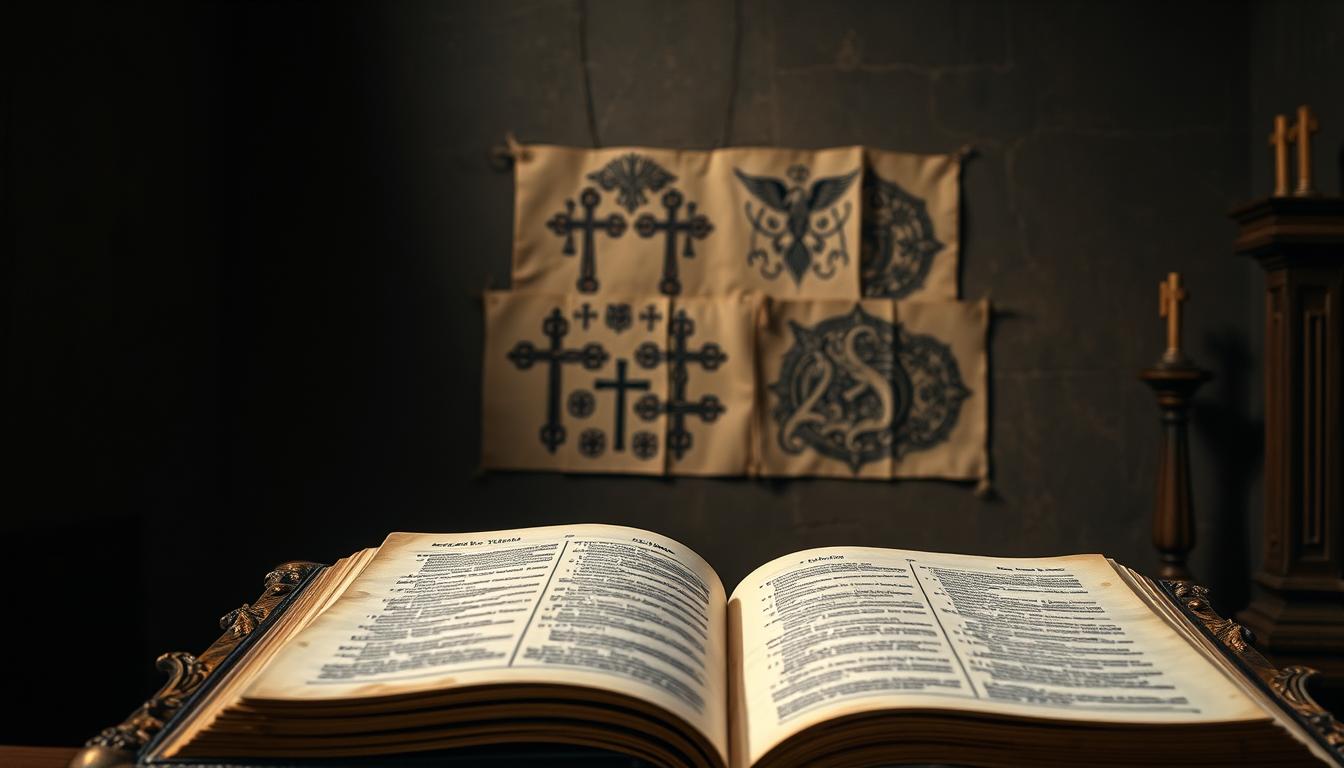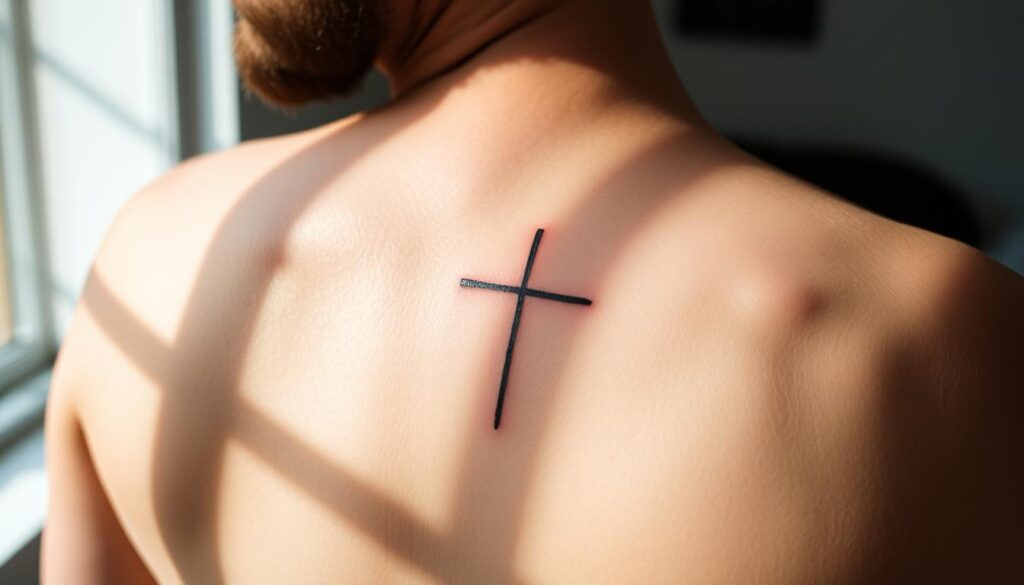
Picture this: You’re standing in a tattoo parlor, ready to make a lifelong commitment to body art. Then a nagging thought hits—does faith forbid this? While scripture contains just one direct mention of markings on skin (Leviticus 19:28), this single verse fuels endless debates among believers.
Modern Christians face unique challenges applying ancient laws. The Levitical code also prohibits beard-trimming and garment blends—rules most don’t follow today. This tension between cultural context and timeless truth demands careful exploration, not quick judgments.
Your personal convictions matter here. Some denominations view tattoos as rebellion, while others celebrate them as worshipful expressions. What unites all perspectives? The need to engage scripture thoughtfully, weighing historical settings against contemporary life.
Key Takeaways
- Only Leviticus 19:28 directly addresses skin markings in scripture
- Interpretations vary widely across Christian traditions
- Cultural context shapes how modern believers apply ancient texts
- Many Christians now view body art as neutral or positive
- Faithful disagreement demonstrates healthy scriptural engagement
This discussion isn’t about right vs. wrong answers—it’s about growing closer to God through honest inquiry. Let’s explore how wrestling with complex texts can deepen trust rather than create division.
Biblical Foundations and Historical Context

Imagine uncovering an ancient scroll with rules about haircuts and clothing choices. That’s Leviticus 19—a chapter mixing practical guidelines with spiritual principles. At its heart lies a command that sparks modern debates: “You shall make no cuts on your body for the dead” (Leviticus 19:28).
Understanding Leviticus 19:28
The original Hebrew reveals nuances often lost in translation. Two key phrases stand out:
- “Cuts for the dead” – Ritual self-harm during mourning
- “Writing marks” – Permanent symbols linked to pagan worship
This verse specifically addressed practices tied to idolatry and ancestor worship. Ancient cultures used body markings to:
- Communicate with spirits
- Honor deceased relatives
- Display allegiance to deities
Old Testament Laws and Their Significance
You’ll notice this law appears alongside rules about harvesting fields and charging interest. The context shows God’s desire for Israel’s distinct identity—not just personal piety.
Consider these three categories of Levitical commands:
- Moral laws (timeless principles)
- Ceremonial laws (temple practices)
- Civil laws (national governance)
Most scholars place the cuts body dead prohibition in the ceremonial category. This explains why early Christians didn’t enforce it while upholding moral laws like “love your neighbor.”
The closing phrase “I am the Lord” reminds us these commands flowed from divine authority. Yet Jesus later fulfilled ceremonial requirements through his sacrifice, reshaping how believers apply Old Testament teachings today.
Cultural and Historical Perspectives on Tattooing

Long before tattoo guns buzzed in studios, our ancestors used skin markings for survival and symbolism. The 5,300-year-old Ötzi mummy reveals 61 simple tattoos—lines and crosses near joints, likely serving as primitive pain relief rather than art.
Tattoos in Ancient Civilizations
Egyptian women wore tattoos as spiritual armor. Archaeologists found dotted patterns on female mummies’ thighs and abdomens—marks believed to protect during childbirth. Captives faced a darker reality: branded with gods’ names to signify temple ownership.
In Mesopotamia, skin markings identified social roles. Priests bore symbols of deities, while laborers carried ownership stamps. These permanent marks functioned like living resumes in societies without written records.
Idolatry, Mourning, and Ritual Practices
Canaanite rituals took body modification further. Mourners gashed their skin to honor gods like Baal, as described in 1 Kings 18:28. Scarification—not ink—dominated these death rites, creating raised marks through controlled injury.
Surprisingly, no Middle Eastern burial sites show evidence of decorative skin art. This challenges assumptions about ancient mourning practices. The prohibition against markings likely targeted ritual violence tied to pagan worship, not personal expression.
Understanding these contexts reshapes modern debates. Ancient marks conveyed identity, protection, or oppression—far removed from today’s creative self-expression through body art.
Modern Interpretations of Biblical Tattoo Laws

Navigating ancient texts in modern times requires balancing historical roots with present realities. Many believers wrestle with how Old Testament instructions translate to today’s diverse expressions of faith. This tension becomes vivid when examining body art through a scriptural lens.
How Context Shapes Our Understanding
Cultural context acts like a bridge between eras. The original prohibition against markings addressed specific pagan rituals, not personal expression. Since the New Testament never revisits this rule, many argue its purpose centered on avoiding idol worship rather than banning ink itself.
Consider how time changes applications. Early Christians abandoned food restrictions but kept moral codes. Similarly, modern body art often carries no spiritual baggage. Your challenge? Separating eternal truth from temporary cultural guardrails.
The Role of Jesus in Fulfilling the Law
Christ’s declaration in Matthew 5:17 reshapes the conversation. He fulfilled ceremonial requirements while upholding moral principles. As Paul explains, “Christ is the culmination of the law” (Romans 10:4). This means freedom from ritual codes but accountability to deeper truths.
Here’s the way forward: Ask if a tattoo honors God or distracts from your witness. The New Testament emphasizes heart posture over external rules. While some believers avoid ink to honor tradition, others use it to proclaim their word-inspired stories.
Ultimately, your choice reflects how you apply ancient wisdom in today’s world. The key lies in seeking the truth behind the text rather than clinging to surface-level interpretations.
What Does the Bible Say About Tattoos? Debates and Perspectives

Across pews and pulpits, body art sparks spirited conversations. While some communities maintain strict stances, others embrace ink as cultural canvas. This diversity reveals how interpretation shapes practice in modern faith journeys.
Denominational Divides
You’ll find striking contrasts between religious groups. Southern Baptists often cite Leviticus to discourage markings, while many non-denominational churches view them as personal choice. Seventh-Day Adventists typically avoid tattoos, contrasting with Pentecostal groups where opinions vary.
| Denomination | Stance | Key Reasoning |
|---|---|---|
| Southern Baptist | Discouraged | Literal Leviticus reading |
| Non-Denominational | Neutral | Cultural context focus |
| Lutheran (ELCA) | Case-by-case | Intent matters |
| Catholic | Permitted | No official prohibition |
Shifting Sands of Acceptance
Ancient Jewish scholars set early precedents. Rabbi Judah (2nd century CE) argued only idol-related markings broke prohibition, while others focused on ink permanence. Many today follow this logic, separating spiritual meaning from aesthetic choice.
Modern believers often ask: Does my tattoo honor my values? Some answer with scripture verses inked on skin, while others preserve natural canvas. What unites diverse perspectives? Respectful dialogue that prioritizes heart intentions over external appearances.
Balancing Faith, Culture, and Personal Expression

Imagine standing at the crossroads of self-expression and spiritual conviction—your choices reflecting both personal identity and eternal values. This intersection challenges believers to weigh cultural trends against timeless truths while honoring their unique journey.
Expressing Your Identity Through Tattoos
Modern body art often serves as a canvas for meaningful stories rather than ancient rituals. Many choose designs celebrating spiritual milestones—a cross symbolizing redemption or verses commemorating answered prayers. One believer shared: “My forearm bears Isaiah 41:10—a permanent reminder of God’s faithfulness during chemotherapy.”
Before getting inked, ask: Does this design align with my values? Scripture urges us to glorify God in all things (1 Corinthians 10:31). Some ideas might uplift others, while others could distract from your witness. A tattoo honoring a loved one’s name might spark conversations about hope, while dark imagery could raise unnecessary barriers.
Your body houses the Holy Spirit, making its care both personal and sacred. Consider how modifications might affect relationships or ministry opportunities. A youth pastor might avoid visible ink in conservative communities, while a tattoo artist could use their craft to share faith stories.
Seeking wisdom matters. Talk with mentors who understand your cultural context and spiritual goals. Pray over designs, weighing their potential to point others toward truth. When approached thoughtfully, body art becomes more than decoration—it transforms into a living testimony etched in skin.
Practical Guidance for Making Your Decision
When facing choices that blend faith and personal expression, thoughtful reflection becomes your compass. Start by examining motives—does this choice honor your values or follow fleeting trends? Consider how cultural context shapes both ancient texts and modern practices.
Prayer, Discernment, and Consulting Scripture
Bring your questions to prayer rather than rushing decisions. As 1 Corinthians 10:31 advises, approach every action—including body modifications—as opportunities to glorify God. Ask yourself: Does this align with cultivating “the unfading beauty of a gentle spirit” (1 Peter 3:4)?
Study biblical principles behind the prohibition against ritual cuttings. While modern ink differs from ancient mourning practices, the core call remains: avoid anything distracting from your spiritual witness. Discuss options with trusted mentors who understand your body as a temple of the Holy Spirit.
Remember Romans 14:23’s wisdom—conviction matters more than rule-following. Whether choosing ink or abstaining, let love guide your choices. Through prayerful word-centered reflection, you’ll find clarity that respects both scripture and self-expression.
